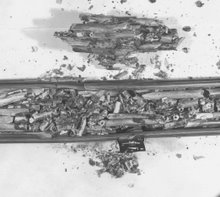Feature Story from today's INL website, go to INL.gov
EPRI, INL Announce Release of R&D Plan Focused on Near-Term Increase in Nuclear Energy Production
The Electric Power Research Institute and the U.S. Department of Energy's Idaho National Laboratory today announced the public release of a joint INL/Nuclear Power Industry Strategic Plan for Light Water Reactor Research and Development. The plan was developed by an industry-lab team and reviewed and approved by the leadership of the INL's Utility Advisory Board and EPRI's Nuclear Power Council.
The plan sets forth two strategies that must be employed for nuclear energy to play a substantial role in meeting future U.S. energy needs. The first strategy is to efficiently construct and operate dozens of new nuclear power plants, starting in the next several years. The second is to maximize the contribution from our existing nuclear power fleet by extending the operating licenses. Implementing both of these strategies will require significant investment in research and development.
"Recent analysis by EPRI shows that all low-emission electricity technologies will be required to satisfy anticipated goals for reduced CO2 emissions - energy efficiency, renewable energy, nuclear energy, and clean coal with CO2 capture and sequestration" said Chris Larsen, vice president and chief nuclear officer for the Electric Power Research Institute. "Industry recognizes that LWR technology is mature and that industry should carry a large portion of the responsibility in maintaining this technology. However, this plan demonstrates that the magnitude of the challenges facing this nation require the active engagement and leadership of the Federal Government in achieving the stretch goals identified in the report."
The proposed industry/government cost-shared R&D effort set forth in the plan is focused on 10 objectives, six of which are considered to be of the highest priority. These high-priority objectives include:
Sustaining the high performance of nuclear plant materials
Transitioning to state-of-the-art digital instrumentation and controls
Making further advances in nuclear fuel reliability and lifetime
Implementing broad-spectrum workforce development
Implementing broad-spectrum infrastructure improvements and design for sustainability; and
Addressing electricity infrastructure-wide problems
INL's Deputy Director for Science & Technology, Dr. David Hill, said "Both the public and private sectors have much to gain from this research effort. Consumers across the country will benefit from avoided emissions of air pollutants and greenhouse gases, reliable baseload electricity, and the creation of thousands of high-wage jobs. Benefits to the private sector include improved plant performance and reduced business risk during new plant development."
Because both the public and private sectors stand to benefit from these strategies, the plan recommends that the research and development program necessary to implement them be pursued through a public-private partnership. The research effort would be managed by a team comprised of DOE, EPRI and Nuclear Energy Institute representatives.
View the plan. ( 1.1MB PDF)
If you view the plan, here is a highlight that the experts are pushing in order to get around some regulations that they are lobbying for change. They really are irked by loss-of-coolant analyses and have been ridiculing those approaches for decades.
8. Extend the application of risk management technologies and understanding of safety
margins
This research area would expand the use of probabilistic risk assessment, risk insights,
configuration risk management, and other risk-based tools to improve safety; optimize
programs, processes, and regulations; and optimize designs for future plants. It would
also develop an improved understanding of safety margins through state-of-the-art
Strategic Plan for Light Water Reactor Research and Development 15
simulation and modeling, reactor safety and design analysis, and risk based technology.
For example, redefining the break size for licensing purposes from the current largebreak
loss-of-coolant-accident basis to a more risk-informed basis may become an
essential prerequisite to life extension beyond 60 years. There is a need to develop pinby-
pin safety margin analysis, which is estimated to take 5 years to achieve. Further, the
recent Kashiwazaki-Kariwa plant earthquake in Japan highlights the need to address
safety margins in seismic design. For plants going to 80 years, this research area would
address how to incorporate the potential changes in failure rates of equipment into risk
calculations. Methodology needs to be developed for representing the impact of aging on
failure statistics. Finally, safety analyses and emergency response guidelines will benefit
from research being performed by the DOE Office of Science into more accurate epidemiological data regarding the health effects of low doses of radiation

No comments:
Post a Comment